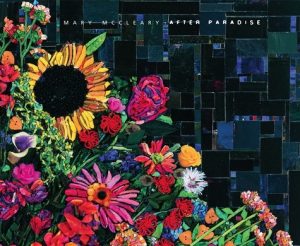The Art of Mary McCleary

I have never seen a work by Mary McCleary in person but wish I could. She makes collages, merging pieces of string, bits of wire, foil, paper, wood and other ordinary things into paintings designed to make the viewer pause and ask questions. Sometimes she incorporates text, even rather long texts into the work. The texts do not explain the work, but seem rather to be one more element to discover in the course of absorbing it. The texts, whether from history, literature, poetry, or scripture, adds another layer of meaning, a reflection on something that both deepens and expands on the theme of the work as a whole. There is whimsy and edginess, touches of both brightness and dreadfulness in what McCleary produces, bright color and muted palates, images that draw us in to reveal the glorious ruin we know so well as broken creatures in a broken world.
“I like the irony,” McCleary writes on her website (marymccleary.com), “of using materials that are often trivial, foolish, and temporal to express ideas of what is significant, timeless, and transcendent.” I see her artistic method as a redemptive technique, taking ordinary things and making them come alive with greater meaning in a larger work of power and beauty. The surface of her works are not smooth and two dimensional, but rough and textured, three dimensional as if inserting itself off the gallery walls and into our existence.
We are introduced to McCleary’s art and life in Mary McCleary: After Paradise. It is a good book, and one I am pleased to have in my library. It contains two short essays, one on McCleary herself by Clint Willour, a curator, and the other on her work by Harold Fickett, author and co-founder of the journal Image. The rest of the book contains full color reproductions of McCleary’s work.
Both essays are thoughtful and intelligent, but neither is for everyone. My one caveat about Mary McCleary: After Paradise is that this book will be primarily of interest to those who already have an appreciation for and understanding of contemporary art. Lay viewers who feel lost in art galleries and who want a beginners guide to understanding McCleary’s work will not find it here. This is not a criticism of the book, though I do wish there was one more essay for viewers who simply don’t get it but wish they could. Mary McCleary’s art is worth getting.
Mary McCleary, for those who prefer a more formal introduction, is Regent’s Professor of Art Emeritus at Stephen F. Austin State University and on the Editorial Advisory Board of Image. She is a Christian whose art helps us see reality with greater clarity, making us stop and think rather than sweep past in our busyness. “Her art,” Harold Fickett writes, “evokes the horror we are so adept at concocting and longs for the blessedness of a new earth characterized by love, justice and peace—by God’s redemption. Her work is an instance of how that process has already begun” (p. 8).

